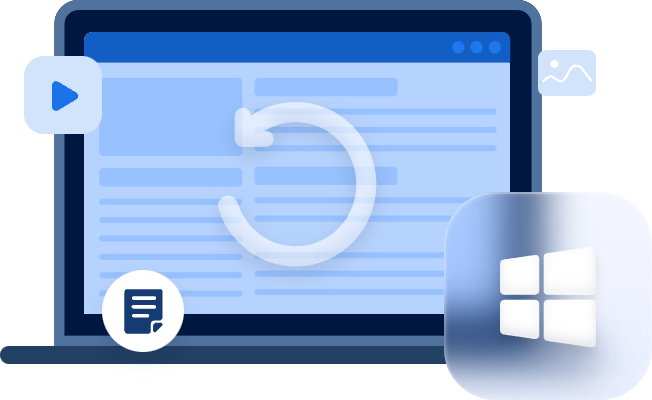Guide: Recover Data from Unformatted Drives
How to recover data from unformatted drives? Get different fixes to recover data from unformatted drives and fix unformatted disks. You can also get some relevant data recovery tips.
What is the unformatted disk?
In computing, an unformatted or raw file system cannot be recognized by Windows OS. After that, your Windows operating system can automatically ask you to format the disk to create a file system. At this point, don’t format and keep this principle this mind.
Likewise, if you receive error warnings as follows, please don’t format them.
The disk in drive is unformatted. Do you want to format it now?
Do you want to format it? F is not accessible?
The volume does not contain a recognized file system.
Can I recover data from an unformatted drive?
In brief, it’s possible to recover data from unformatted drives because partition recovery is the process of recovering data from deleted, missing, formatted, RAW, unformatted, or damaged partitions.
Though Windows cannot open unformatted partitions, most files still can be recovered via professional data recovery tools.
Recover data from unformatted/RAW drive via data recovery software
Are you wondering how to recover data from unformatted drives or RAW drives? Since few users have created regular backups with Windows features or backup software, not to mention restoring your desired data from these backups.
Thus, there’ll be no more better way than using professional data recovery software like MyRecover to recover data from unformatted or RAW drives.
- After recovery, please remember to save these retrieved data in a new location.
- To recover a large number of deleted & missing files from your unformatted drives with ease, you can consider upgrading MyRecover to the Professional or Technician edition.
- ★Powerful features & friendly design of MyRecover:
- Powerful features: Recover deleted & lost Word, Excel, PPT, folders, compressed files, photos, songs, videos, audio, websites, and other 200+ file types from internal/external hard drives.
- Easy-to-find: During Quick Scan and Deep Scan, you can quickly locate your desired files by Filename, Path, Date, Size, etc.
- Convenient: Retain the original Path, Filename, and Format for the deleted files.
- Excellent compatibility: Support NTFS, FAT32, exFAT, and ReFS file systems.
Please download MyRecover on your Windows 11, 10, 8, 7, or Windows Server PC!
Step 1. After running MyRecover on your Windows PC, hover the mouse over your unformatted/RAW drive and click Scan.
Step 2. Filter your needed data according to Name, Date, Document Type, or Path.
- Name: Type the filenames of your desired files to narrow the search area.
- Date modified: Set the date according to your situation (today, yesterday, the last 7/30 days, etc).
- Size: Filter the file size based on your needs (<128KB, 128KB~1MB, 1MB~ 512MB, etc).
Step 3. Go to the Deleted Files/Recycle Bin/Other Missing Files folder and select the files you want to retrieve. Then click “Recover x files” to start Windows data recovery.
Bonus tips: How to fix unformatted hard drives?
After retrieving data from unformatted/RAW drives, you can utilize the Windows built-in utility or partition manager software to check & repair errors.
Fix 1. Check & repair unformatted disk errors with Windows built-in tool
Windows has provided an efficient built-in tool for users to check and repair their drives. If there’s something wrong with your drives’ file systems, you can run this tool.
Besides, this solution also can help you recover from USB drive without formatting.
Step 1. Press “Win + E” to open File Explorer and right-click on your selected internal or external hard drive.
Step 2. Select Properties. Under the Tools tab, click the “Check” button.
Step 3. Click the “Repair this drive” button and wait patiently.
Fix 2. Format the unformatted disk via Disk Management
Are you also wondering how to fix unformatted hard drives? Another powerful system utility, Disk Management is good for Windows users to execute varied advanced storage operations. Let’s show how it works.
Step 1. Type “Disk Management” in the search bar and open it.
Step 2. After seeing all the partitions, right-click on the unformatted partition and select the “Format” option.
Then you can go to your File Explorer to see if this drive is accessible to you or not. In addition, the following AOMEI Partition Assistant Standard also can help you format partitions without paying.
Fix 3. Fix errors & rebuild the MBR of the unformatted disk
If the above fixes are useless, why not help from the powerful and free AOMEI Partition Assistant Standard to check bad sectors and rebuild the MBR of your unformatted disk?
▶Check and fix errors on your selected partition
Step 1. Install free AOMEI Partition Assistant Standard on your Windows 11, 10, 8.1, 8, 7, Vista, or XP computers.
Step 2. On the main interface of the tool, right-click on your selected partition including your needed data. Then click Advanced > Check Partition.
Step 3. Select Check Partition and fix errors in this partition by using chkdsk.exe > click OK. If your hard drive is in RAW format, please select the last option.
Then click “OK” to exit this window.
▶Rebuild the MBR of your unformatted disk
Step 1. Right-click on your selected unformatted disk and choose the “Rebuild MBR” option.
Step 2. Choose the operating system you’re using and click the “OK” button.
Step 3. On the main interface, click Apply > Proceed.
Related Q&A about internal/external hard drive data recovery
If you’re eager to recover data from unformatted drives, please consider using the above-recommended data recovery software. And the sooner you begin the data recovery with MyRecover, the better chances you’ll be.
Apart from that, there’re some tips about internal & external hard drive data recovery.


